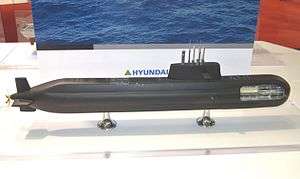Dosan Ahn Changho-class submarine
Dosan Ahn Changho class submarines are the final phase of the Korean Attack Submarine program, a three-phased program to build 27 attack submarines for the Republic of Korea Navy between 1994 and 2029.[2] The lead vessel Dosan Anh Changho was launched in 2018. It began sea trials in 2019 and will be ready for service by 2020.[3]
 model of the Dosan Ahn Changho-class submarine | |
| Class overview | |
|---|---|
| Builders: |
|
| Operators: |
|
| Preceded by: | Son Won-il class submarine |
| Cost: | US$ 900,000,000 |
| Built: | 2016–present |
| In service: | 2020 schedule |
| Planned: | 9 |
| Building: | 2 |
| Completed: | 1 |
| General characteristics | |
| Displacement: | (Batch I) 3,358 t surfaced, 3,750 t submerged |
| Length: | 83.5 m |
| Beam: | 9.6 m |
| Draught: | 7.62 m |
| Propulsion: |
|
| Speed: |
|
| Range: | 10,000 nm |
| Endurance: | 50 days |
| Complement: | 50 |
| Armament: |
|
This new class will have a submarine version of the Korean Vertical Launching System which will be able to carry up to 10 indigenous "Chonryong" land-attack cruise missiles and "Hyunmoo" submarine-launched ballistic missiles,[2] becoming the first submarine in the South Korean navy to have this kind of capability. It will also have many other improvements compared to its predecessors built with a greater degree of South Korean technology, especially in the later batches, which will include Samsung SDI lithium-ion batteries.[4][5] Measured to weigh over 3800 tonnes submerged during sea trials,[3] they are the largest conventional submarines ever built by South Korea. The Batch II vessels will increase their displacement by approximately 450 tonnes (4,250 tonnes submerged), according to the Defense Acquisition Program Administration.[6]
The 2nd vessel of first batch was observed nearing completion in the Geoje shipyard of Daewoo Shipbuilding & Marine Engineering on May 12, 2019.[7]
KSS-III Batch II[8]
On April 25, 2016 there was a Congressional Hearing session held immediately after North Korea's SLBM launch, which raised some important questions about the ROK Navy's submarine capabilities to counter this threat.
In response to questions whether ROK Navy was currently developing capabilities to counter SLBM threat, the ministry confirmed that KSS-III Batch-II will undergo redesign process before construction (lasting until December 30, 2018) to accommodate some important capability upgrades. These upgrades will give the Batch-II Submarines better capabilities at both attacking strategic land-based facilities and performing anti-submarine warfare.
According to the recent DAPA statement, the Next Generation Submarine Project Team held a "System Functional Review" meeting on KSS-III Batch-II submarine in late June 2017. Through this meeting, the project team was able to confirm the design requirements for the Batch-II submarine under development are well reflected in the design. As a result, following the Batch-I, the Batch-II program has been promoted and the design has begun to materialize.
Expected changes of Batch-II compared to Batch-I:
» Lengthened hull (approximately 6 meters)
» Increase of VLS cells from 6 to 10
» Indigenous combat system and sensors
» LiB and, potentially, High-Temperature Superconductor (HTS) motor for integrated full electric propulsion system
Ships in the class
| Name | Pennant number | Builder | Laid Down | Launched | Commissioned | Status |
|---|---|---|---|---|---|---|
| ROKS Dosan Ahn Chang-ho | SS-083 | DSME | 17 May 2016 | 14 September 2018 | Under testing | |
| ROKS Son Byong-hi | SS-085 | DSME | 17 April 2018 | Under construction | ||
| ROKS Yi Dong-nyeong | SS-086 | Hyundai Heavy Industries | 11 April 2019 | Under construction | ||
| ROKS Lee Bong-chang | SS-087 | DSME | ||||
References
- 월간수소경제: 연료전지시장 '빅뱅' 예고한 '범한산업' 02. October 2018
- South Korea’s First-of-Class KSS-III Attack Sub Begins Sea Trials: The Diplomat
- South Korea’s first KSS-3 submarine begins sea trials: Jane's
- South Korea approves procurement of next batch of Aegis destroyers, subs: Naval Today
- DSME Jangbogo-III Batch-II Pilot Design Has Come to an End: Navy Recognition
- South Korea to build 3 more Aegis destroyers able to thwart ballistic missiles: Defense News
- 도산 안창호급 2번함: Bemil, Chosun Ilbo
- DSME Launched ROK Navy's 1st 3000 tons KSS-III Submarine Dosan Ahn Chang-ho: Navy Recognition